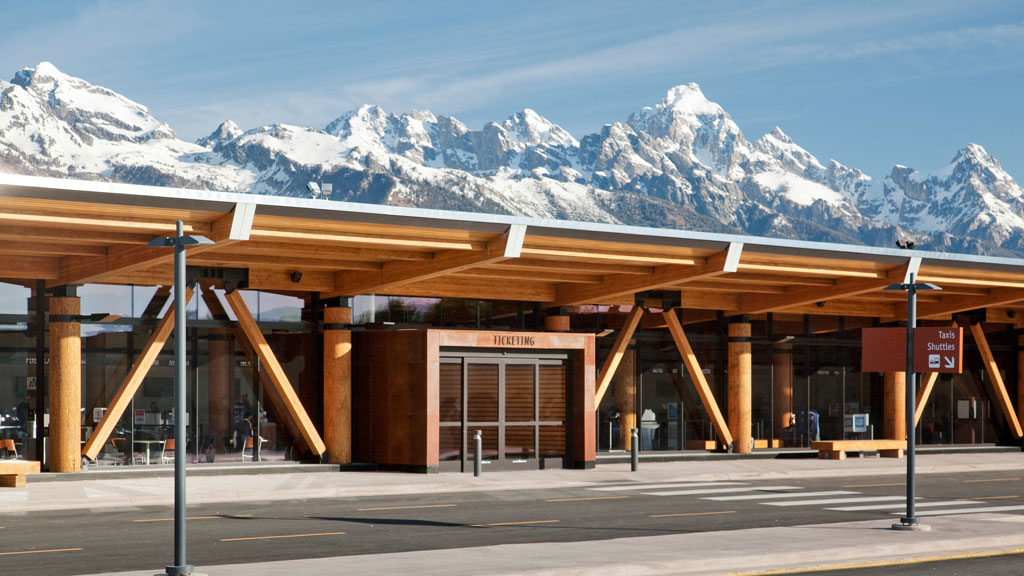From Mill Towns to Cities: How the Mass Timber Revolution Is Impacting People and the Planet
May 31, 2024 | By Erik Barth and Katie Mesia
Picture a rural mill town in northern Maine in the early 20th century: the local economy is booming, with ample employment opportunity centered around the burgeoning pulp and paper industry housed in the impressive post and beam masonry structures that anchor the heart of the downtown. The flow of the local river is the lifeblood to the economy. The river, like the raw lumber that flows down it during the logging runs, originates from extensive forest watersheds complete with eastern white pine, spruce, hemlock, firs, and a wide variety of hardwood species. Logging companies work in concert with the mill operations to harvest and manufacture wood products. The forest and natural ecosystems directly fuel the socioeconomic health of this small town.
Despite the prosperity, there are significant environmental challenges to this model — clear cutting and unsustainable forestry was the common practice in this era due to the perception of an inexhaustible forest resource. Compare this picture to that of today: many rural mill towns in Maine and around the United States are languishing socioeconomically, as paper, pulp, and textile mill products were outsourced overseas or no longer needed with the advent of the digital age. The once proud mill buildings sit idle or are slowly converted to new uses. The younger generation moves away to seek better job opportunity in more urban settings. Instead of clear cutting, forests are managed more sustainably, but are largely underutilized. According to the 2024 International Mass Timber Report, forest stock has increased each year over the last 50 years nationally, indicated by an average 110% or 1.10 ‘growth to drain ratio’, or the annual amount of wood fiber a specific area of land can grow annually (accounting for insects, disease, and wildfire) to the quantity of harvested timber. The disconnection between the forest resource availability and labor availability is a significant missed opportunity to bring life to rural economies both in this illustration in Maine and across North America.
What if there was something the design industry could do to revitalize rural communities with access to abundant, renewable forest resources? What if we capitalize on the opportunity to create a more symbiotic relationship between forest resources and rural communities, where sustainable silviculture is implemented alongside advanced forest product manufacturing facilities?
This opportunity could easily be missed — the U.S. Department of Labor is predicting a net loss of employment in the wood products industry and construction industries over the next 10 years, despite increases in demand. The logging industry is predicted to have the most significant gap, with an inverse relationship between employment and output or demand. Forest products represent an opportunity in multiple dimensions: by creating job opportunities to better the health of rural communities and sequestering carbon at a large scale through sustainable forest management and the use of biobased wood products in the construction and consumer products industries. In the design and construction industry specifically, this means looking at wood products like mass timber. By consistently using mass timber as a construction material at a large scale, the wood products supply chain can stabilize and grow, simultaneously stimulating rural economies.
So why has this opportunity not yet been realized at scale? There are several significant barriers and challenges that the industry needs to overcome. The overarching challenge in the North American mass timber market is that it is still in the early stages of development, which comes with inherent risk. Mass timber products like cross laminated timber (CLT) and glued laminated timber were first produced on a large scale in Europe in the mid to late 20th century. Product development standards and market maturity in North America has generally lagged behind the European market by 10-15 years. The quality of North American timber products has been inconsistent, leading to larger risk. Manufacturers are rarely vertically integrated, meaning that products are handled by a complex ecosystem of companies that only engage in one part of the harvesting and manufacturing process. This leads to further risk associated with quality control and assurance.
As a tangible example, a contractor can go to a lumber yard and buy a 2x4 piece of dimensional lumber sourced from a wide from a variety of manufacturers and be confident it will perform essentially the same. In contrast, each manufacturer of CLT and glued laminated timber in North America have different product sizing catalogues and processes. This leads to inefficiency and risk in both the design and construction process, as variable sizes of mass timber elements need to be accounted for before procurement occurs. Adding to these challenges, there have been relatively few mass timber buildings constructed in North America to date, meaning there is little historical data on failure — which translates to comparatively high insurance rates for mass timber buildings. Add on interest rates that have peaked above 7% in the last year, and even the most well-intentioned developer faces an extraordinary challenge to commit to and realize a mass timber building.
Despite these significant challenges, there are many opportunities and assets available to mass timber buildings and the supporting industry. The gap of infrastructure and knowledge between the U.S. and Europe is rapidly decreasing, as the number of mass timber projects and corresponding experience rapidly increases, and European manufacturers invest in the North American market to share expertise, equipment, and best practices. As there are few constructed mass timber buildings in most of the U.S, they are still significant market differentiators for projects like class A office space and residential projects in the 6-12 story range that don’t directly compete with light wood frame construction. Higher education institutions like Princeton and University of Massachusetts Amherst have used their development models to invest in and push forward the mass timber movement. Mass timber projects can be framed typically 20-30% faster than comparable steel or concrete buildings, saving time and money.
In the face of decreasing labor availability in the building trades and high labor costs, mass timber presents a financially viable solution by requiring only 25% of the installation labor force and creating higher paying jobs in factories. Mass timber fabrication and installation is also much safer and less toxic to workers than steel or concrete, due to the composition of the materials.
For the end users of these buildings, the biophilic benefits of mass timber as an exposed structural material are also significant. One study found that biophilic design improved workers productivity by 6% and creativity up to 15%. The historical updates to the 2021 International Building Code open the door to significant increases in height and area for mass timber buildings. Taken together, these many benefits of mass timber construction pose a strong challenge to the notable barriers to implementation. Bold, informed action done collaboratively between all players in the building industry can both mitigate the real risks and realize the incredible opportunities of this compelling new construction material.
For media inquiries, email .


